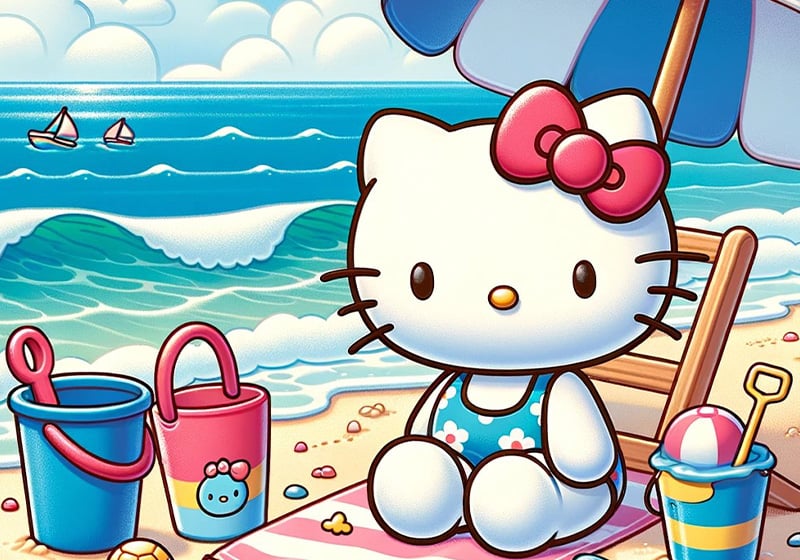Table of Contents
Fifty years ago, a Japanese icon was quietly born. Today, that character is one of the world’s most recognisable brands: Hello Kitty.
Everybody knows the adorable white kitten with no mouth and pretty red bow on her left ear. Exactly 50 years ago – in 1974 – this cute kitten appeared for the first time on a plastic purse. Five decades on, Hello Kitty is a multi-billion dollar brand and a ubiquitous character in global pop culture.
Today, we’re telling the story of Hello Kitty and how the world is celebrating her birthday…
Who is Hello Kitty?
Let’s start from the beginning. Hello Kitty is a fictitious character created by Japanese designer Yuko Shimizu. She is a kitten, or rather an anthropomorphised version of a white Japanese cat.
Her identifying features are no mouth – some say that it’s simply hidden under her fur – and a fetching red bow. Sanrio, the company that owns the brand, have always maintained that the absence of a visible mouth symbolises the fact that Kitty doesn’t speak any one language. That way, it’s left to those interacting with Kitty to project their own emotions onto her and build a direct relationship with the character.

There’s scant information out there about Hello Kitty and it is perhaps this – together with minimalist design – that has made Kitty a universal character. We know her full name – which is Kitty White – and that she lives in London with her family: mum, dad and twin sister Mimmy (distinguishable by a yellow bow). We also know that she was born on 1 November, which makes her a Scorpio, and that she is the height of five apples and weight of three. But the most important thing we know about her is that she has a heart of gold and loves to make friends.
These and a few other details known about her – like her passion for apple cake, music, reading and travel – have made Hello Kitty a global pop-culture icon. How did this happen?
The Hello Kitty story: how an icon was born

What today is a superstar brand was created almost by accident in a Japanese company that started out making rubber sandals and other accessories: Sanrio. It was the sixties, and the firm’s founder – Shintaro Tsuji – realised that his shoes sold much better when they were decorated with cute flowers. So, to beautify his products, he hired some graphic designers, one of whom was Yuko Shimizu, the “mother” of Hello Kitty.
In 1974 Yuko Shimizu drew a kitten – with no mouth, blue overalls and a red bow – to print on a little vinyl wallet: Hello Kitty was born!

Among the inspirations cited by the designer – who would leave the firm to turn freelance two years later – was Through the Looking-Glass, Lewis Carroll’s sequel to Alice in Wonderland: at the start of the book, Alice plays with a black cat called “Kitty”.
Some claim that Hello Kitty is also inspired by the Japanese bobtail cat, a breed noted for its extremely short tail. According to others, a source of inspiration was the maneki neko – a traditional Japanese good-luck charm in the shape of a cat.

Image: commons.wikimedia.org [CC0 1.0 DEED]
These days, Sanrio’s Hello Kitty is drawn by Yuko Yamaguchi.
Hello Kitty and the kawaii aesthetic
Today, Hello Kitty is a lucrative global phenomenon, estimated to be worth 8 billion dollars in 2013. Indeed, the brand was a success from the outset: Sanrio’s profits soared soon after Hello Kitty launched in the seventies.
During Japan’s economic boom in the eighties, a new aesthetic emerged that would take the world by storm. It was the culture of kawaii – a Japanese term meaning “cute” that is used to describe an innocent, almost cartoonish style big on pastel colours (read our deep dive on pastel colours here) and cheerful yet minimal design elements.
And the most famous example of the kawaii aesthetic is without doubt Hello Kitty.
Hello Kitty: friendship symbol and fashion icon
But Hello Kitty is not just about cuteness. The way it conveys a sense of simplicity and joy has made it a universal symbol of friendship. UNICEF – the United Nations Children’s Fund – appointed the brand as an ambassador for children around the world. And the Japanese government has also used Hello Kitty to promote the country, including at Expo 2015 in Milan.

Meanwhile, the Hello Kitty face has adorned all manner of clothes and accessories: tote bags, wallets, socks, T-shirts, underwear, onesies and more. Many major brands have launched collaborations with the Sanrio character, like Levi’s and its 2019 collection.

Hello Kitty’s 50th anniversary
This year, the world celebrates the 50th birthday of this pop culture icon, and Sanrio has created a special anniversary website to mark the occasion.

And more major collaborations are planned with global brands, including fast-food multinational McDonald’s, footwear manufacturer Crocs and watchmaker Casio.

Sanrio will also be launching an augmented-reality app, a national tour in Japan and other events around the world, like this one held in Santa Monica, California, with giant Hello Kitty inflatables floating around inside an aircraft hangar!
How will you be celebrating Hello Kitty’s 50th anniversary? And will you be using the kawaii aesthetic for your next project?
Would you like to help us add to or improve the content of this article? Check our guidelines and send us your request via email at: seo@pixartprinting.com.

